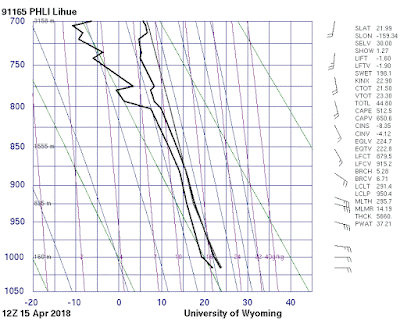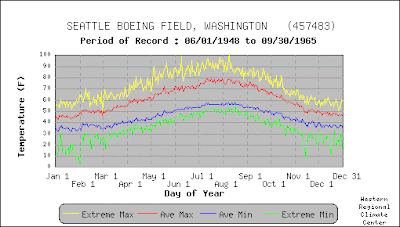But additional precipitation records have become available and it now appears that the precipitation in some locations went beyond extraordinary, producing 24-h amounts that have never been documented anywhere in the U.S. at any time: the all-time 24-h precipitation record of the United States.
That is something amazing.
This week the National Weather Service released a special statement that a rain gauge in Waipa, about a mile west of Hanalei, on the north side of Kauai, received 49.69 inches during the 24 hours ending 12:45 PM HST on Saturday April 15th (that is 2145 UTC/GMT). As an aside, the message was written by Kevin Kodama, the NWS Service Hydrologist in Honolulu, and a graduate of the UW Atmospheric Sciences department).
An official review team will evaluate the quality and consistency of the rain gauge data to determine whether the record was actually broken. This was not an official NOAA rain gauge but one installed by the Waipa Foundation. If true, the April 14-15th total would smash the previous U.S. 24-h record of 43 inches observed in Alvin, Texas on July 25-26, 1979.
There were a number of other extremely heavy rainfall observations in the area, so it is possible that this value is valid. For example, the nearest station I could find as a weatherunderground.com site in Hanelei (KHIHANAL2, see map).
On April 14th, this location received 23.05 inches, with 21 inches of it after 12:45 PM.
On April 15th, that site observed 20.43 inches in less than 4.5 hours before their power failed at 4:24 AM (see below).
 This is incredible. An average of 4.6 inches per hour.
This is incredible. An average of 4.6 inches per hour.But it is more incredible than that....here is a plot of the precipitation that morning at that location, showing both cumulative rain and inches per hour. About half of that rain occurred over 1.5 hours with intensities approaching 10 inches per hour.
So adding up the precipitation at that site from 12:45 HST April 14th to the time of failure (4:24 AM April 15th) gives 41.43 inches... and the event was not over. The 49.69 inches a mile west at Waipa sound pretty believable considering the Hanalei observations.
And what happened on the ground makes these huge totals believable. Here is a video of a pass by a Coast Guard helicopter over the heavy precipitation area. This area got hit very, very hard.
But the question that you are asking is why? What conditions produced such amazing rainfall on the north side of Kauai? I love exploring a meteorological mystery--so let's tear this situation apart and find out what happened.
First, consider the location of the rain gauge, in the town of Waipa. As shown by the map, this location is near the north coast of Kauai-- very near but upstream of the substantial terrain of the island. Essentially, an area where major terrain extends practically to the coast line.
Since terrain enhancement may be an important element of this event, let's zoom in and look at the neighborhood carefully. The location in question is about a mile west of the famous town of Hanalei. The proximity to the terrain is probably very important...more on that later.
Just to get our bearings... the 24h period of interest is 12:45 HST (2145 UTC) April 14 to 12:45 (2145 UTC) HST April 15th.
A key element of this event was strong easterly flow in which there were intense and persistent thunderstorm (convective) activity. The easterly flow is also known as the trades (or trade winds), with some folks referring to this event as "thundertrades".
The University of Washington WWLLN lightning detection network, run by Professor Robert Holzworth, documented the lightning strikes during the event. Here is graphic he shared with me of the strikes during the period of this event (below).
Just stunning. A huge collection of lightning strikes over the northern and northeast side of Kauai (over 3000 of them).
Lightning observations and surface reports documented hour and after hour of heavy thunderstorms over that region? Why?
To start with, there was strong, moist, unstable trade winds approaching northern Kauai. An excellent way to see this is to look at the analyses and forecasts of the NOAA/NWS High Resolution Rapid Refresh (HRRR) for Hawaii (HRRR-Hawaii). Here are winds analyzed at 80 m (about 260 ft) at four times bracketing the event (1800 UTC 14 April and 0000, 0600 and 1200 UTC 15 December). You will notice that during the central portion of the event, moderate northeasterly flow impacted the northern portion of Kauai, with air forced upward by the terrain.
There is upper air (radiosonde, balloon launched with observations) at Lihue, on the eastern side of the island. Here are plots of temperature (right line), dew point (left line) and winds at 0000 and 1200 UTC 15 April. The x-axis is temperature (C) and the y-axis is height in pressure (700 is above 10,000 ft, 850 is 5000 ft).
At 0000 UTC 15 April, there was a 5000 ft layer of saturated or near-saturated air with easterly/northeasterly flow. This air was characterized by low stability, which means that instability (convection/thunderstorms) would have a tendency to be released as the air was forced to rise. The moist layer deepened by 1200 UTC 15 April, with substantial wind shear in the lowest 10,000 ft.
A significant upper level feature--an upper level trough--extended over Kauai during this event. This is shown by the upper level height anomaly for 500 hPa (about 18,000 ft) shown below. The blue and purple colors show areas where heights and pressures are much lower than normal. Troughs aloft are associated with upward motion and cool air in the lower portion of the atmosphere.
This upper level trough helped bring large (but not record-breaking) amounts of water vapor northward over the islands. This graphic show upper-level winds and water vapor from the GOES-15 satellite. You can see strong southerly winds aloft pushing water vapor northward aloft.
And a satellite view shows the total water vapor in a column Saturday morning--substantial values over Hawaii.
According to NESDIS (the NOAA satellite service) they had about 175% of normal water in the column...high, but not even in the top 40 water vapor events.
Thunderstorms are encouraged by increased change in temperature with height. During this event, temperatures were unusually cold aloft, as shown by the temperature anomaly plot for 500 hPa (about 18,000 ft), shown below. Cold anomalies are right over the islands aloft.
At the same time, temperatures were above-normal near the surface (1000 hPa), as shown below.
As a result, there was an usually large cooling with height, and a very important measure of convective potential, the lifted index, was lower (more unstable) than normal:So everything came together for this event.
There were moderately strong easterly to northeasterly winds approaching the northern coast of Hawaii....this air was primed for instability, so the upstream effects of terrain caused the air to rise and convection/thunderstorms to be released. Thunderstorms continuously developed over northern Kauai, dumping huge amounts of rain fostered by the deep moist layer approaching the island. And the area in question was simply ideal, with high terrain extending to the coast. But no one element was particularly extraordinary....but the sum of all of these elements were. Sort of like six dies coming up with the same number.
The unusual combination factors came together to give us extreme precipitation, with a small enhancement by the warming of our planet, which results in the atmosphere containing more moisture (but that can't be the primary explanation of this huge event).
Our models did predict substantial rain, but nowhere as much as occurred. Here is the 24h precipitation forecast by Hawaii HRRR for the run initialized at 1200 UTC 14 April (Friday morning). Not great...it showed are area of 4-6 inches (which is heavy) on the north side of the island, but nothing like the big totals observed that day. The origin of this forecast failure needs to be examined.
























































